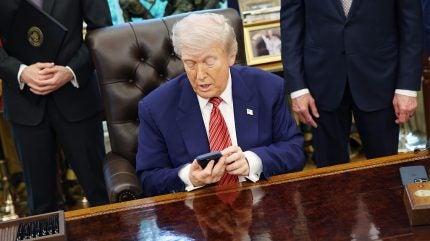
Despite Apple CEO Tim Cook’s historically cordial relationship with US President Donald Trump, the tech giant’s supply chain is now the latest target of another one of Trump’s tariff threats. It comes as a new book reveals details of the company’s decades-long involvement in China, and argues that Apple laid the foundation that has allowed Chinese tech to compete with the US.
Last week, Trump threatened to impose 25% tariffs on iPhones if Apple did not fully shift its production from China and India to the US.

Discover B2B Marketing That Performs
Combine business intelligence and editorial excellence to reach engaged professionals across 36 leading media platforms.
“I have long ago informed Tim Cook of Apple that I expect their iPhones that will be sold in the United States of America will be manufactured and built in the United States, not India, or anyplace else. If that is not the case, a tariff of at least 25% must be paid by Apple to the US,” Trump posted on his social media platform, Truth Social, last Friday (23 May). At a press conference later that day, he said this would also apply to other phone companies such as Samsung.
The threat came after the Financial Times reported that Apple would invest $1.5bn into manufacturing in India through its long-time manufacturer Foxconn in order to shift iPhone production away from China. Apple’s plan to increase investment in India to counter high tariffs in China was first reported by Bloomberg a month ago.
During Trump’s Middle East tour last week, he highlighted his discontent over this move.
“I had a little problem with Tim Cook yesterday,” he said during a state visit to Qatar. “He is building all over India. I don’t want you building in India,” Trump said he told Cook.

US Tariffs are shifting - will you react or anticipate?
Don’t let policy changes catch you off guard. Stay proactive with real-time data and expert analysis.
By GlobalDataApple’s decision to shift production to India was prompted by the US and China’s trade war, which saw tariffs reach 145% before the two countries agreed to a 90-day pause. Around 90% of Apple’s products are made in China.
A new book by journalist Patrick McGee, Apple in China: The Capture of the World’s Greatest Company, argues that the US company’s massive foreign investment and involvement in China were crucial in transforming the country’s economy and tech sector. He explains that contractors for Apple, such as Foxxconn, passed on tech expertise to Chinese competitors like Huawei. “China wouldn’t be China today without Apple,” McGee argues.
The Biden and Trump administrations have both tried to limit China’s development of sensitive technologies such as semiconductors through policies that disrupt their supply chains.
McGee highlights that Apple has trained more than 28 million workers in China since 2008 and at one point was investing $55bn a year there (according to internal documents he obtained for the book). He says these investments are more than double the figure that former US President Joe Biden spent on the CHIPS Act.
If the tariff is put in place, it would raise prices for consumers in the US.
“iPhone tariffs will mean higher prices – probably $100 more per iPhone. It will only dampen sales marginally because the iPhone is a must-have item. No one will quit their iPhone, but some will delay the upgrade to a new model,” Kevin O’Marah, co-founder of supply chain research company Zero100 and former director at Amazon, said in a note.
“Apple can also afford to eat some of the tariff cost by edging up prices on their digital services to help cover and maintain margins. I don’t think Apple will be willing to yield much margin, especially with the OpenAI/Jony Ive challenge on the horizon,” O’Marah added. He is referring to the recently announced collaboration between former Apple designer Jony Ive and OpenAI to create AI products.
India was hit with 26% reciprocal tariffs from the US in April, as varying rates were announced for countries worldwide. These were paused a few days after they were announced, but if the two countries fail to reach an agreement, they will go into effect again this July. Hopes are high that India will manage to maintain a low tariff rate with the US, particularly after US Vice-President JD Vance’s visit to Indian Prime Minister Narendra Modi in April.
“If you are a company that left China because you thought you were doing the right thing by moving your supply chain out of China, because that is what the political world wanted […], then you are facing these [reciprocal tariffs]. You are penalised for making the right decision,” Ed Brzytwa, vice-president of international trade at the Consumer Technology Association, told Investment Monitor at an investment conference a few weeks ago.





